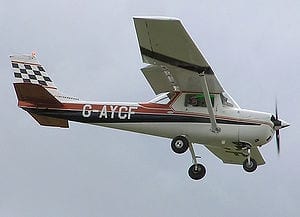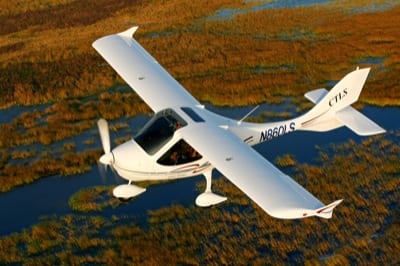General Aviation News columnist Dan Johnson recently wrote about LSAs vs. Cessna 150s. The post discusses the pros and cons of a new Light-Sport Aircraft versus the venerable Cessna 150. Dan was a long-time 150 owner and is “the man” when it comes to new LSAs, so he’s as much an expert on both — at the same time — that any of us could hope to find.
Suffice it to say, neither a brand-new LSA or a 30-year-old 150 is the perfect airplane for everyone. The comments quickly evolved into most “cost-effective” and most “expensive” arguments. Very black and white, which makes no sense to me.
Like everyone, I wish new aircraft — LSA or otherwise — carried lower price tags. Alas, they don’t. But I’ve grown weary of the “new LSAs are too expensive” argument. Affordability is relative. Some can afford a new CTLS, while others can afford an 1/8-share of an Aeronca Champ.

In either case: GREAT! Aircraft ownership is shades of grey. And as pilots, we are supposed to have a keen situational awareness, yet so many become quickly myopic.
Everything in aviation is a trade-off, so the discussion should be a personal in nature. An aspiring pilot should be asking themselves (among other questions) what kind of plane do I want to learn in? That answer is entirely personal. Some will be drawn to the romance of yesteryear and a J-3 or Aeronca; others will get a charge out of learning in a glass panel-equipped CT from Flight Design. For either student, the plane that motivates them to spend every free moment flying, learning about flying, reading about flying, or studying about flying is the right plane for them.
Flying means different things to different people. Some want to justify ownership for business purposes. Some just want to own a plane for pure recreating. Breaking down the finances on someone else’s choice is foolhardy at best, and can be downright offensive at worst.
Like boats or motorcycles or RVs, there are many sizes, shapes and colors of airplanes. Thankfully.

The simple answer, for me at least, is a person just has to WANT to own an airplane. For those who can afford to buy a new [insert aircraft here], the pull, I believe, is the intangible. How do you quantify meeting with clients in three different cities and still being able to make your kid’s soccer game that night? (I know, cliche, but still apt.) For those who own a 65-year-old J-3 Cub, it’s no different than owning a collector car or motorcycle or boat. You want it. You may not golf or ski. This plane is your drug of choice.
So, let’s get off the subject of “affordability” in general aviation. For those saving up for that 1/8-share of a Champ, I say bravo. For those desiring a new CTLS or Cirrus, fantastic. To both I ask, can I have a ride?
I don’t much care what you fly, how much it costs you or what you do when flying. I’m just thrilled you do. That’s what we need — aviators.
Ben Sclair is Publisher. He can be reached at [email protected]
People who read this article also read articles on airparks, airshow, airshows, avgas, aviation fuel, aviation news, aircraft owner, avionics, buy a plane, FAA, fly-in, flying, general aviation, learn to fly, pilots, Light-Sport Aircraft, LSA, and Sport Pilot.

Thanks Ben for a voice of reason. People are comparing apples to oranges in terms of technology and cost. A new LSA has a panel more advanced than the Apollo capsule and materials like carbon-fiber composites that did not exist when I learned to fly (in C150s of course) in 1973. Yet the new price of an averged-equipped LSA is no different than an average-equipped Cherokee 140 or C152 in the early 1970s – compared to minimum wage, the average salary of a pilot, or a whole host of other things. I did the numbers recently and found that for a 20 hour minimum wage job in 2012 I can fly more hours dual in a new LSA than I could in a new C152 in 1973 when I was pumping avgas and cleaning planes at a big FBO. And I’d be flying an airplane today with technology and safety features not even dreamed of in 1973.  I agree too that it is nuts to buy an airplane, park it in a hangar and fly it only 50 hours a year. Europeans figured that out decades ago and have perfected the flying club concept, many even owning their own airfields, doing their own maintenance, and providing places for pilots to stay overnight cheaply.  Spend a week’s vacation on such a field and you can do a great deal of flying.  That’s probably why so many of the new LSAs come from Europe where the clubs have made it possible to afford advanced aircraft at a fraction of the cost of owning one yourself.  I like this conceot so much that a few of us in central NC have formed the Bear Creek Aero Club to build/restore airplanes together then fly them at rock-bottom prices. It is time to look ahead and stop dreaming about this past.  There are ways to keep flying even on a very small income or retirement.
Kent, I had some numbers that I thought said something similar – that the price of an airplane divided by the average industrial wage (with benefits) actually hadn’t changed since the late 1950s. I tried to reproduce the analysis recently and found that the ratio has doubled. Do you have data sources you can cite?
Bravo. While there are many artificial reasons for the high cost of new airplanes (LSA or other), the number one thing we can do as aviators is, well, aviate. If we can get away from the mentality that owning a whole airplane is somehow “better” than owning a share, and if we can build the pilot population, those two things will lower the real cost of ownership, making aviation more affordable for all of us while opening the experience to others. I own a 150 and I took my first ever flight in an LSA a couple days ago. Many differences to be sure. But both are AIRPLANES and both enabled me to FLY. If you think like that, the esoteric differences tend to fade away. We need more Bens and Dans. I follow both, so keep it up!
Len Assante, VP Communications, Aviation Access Project